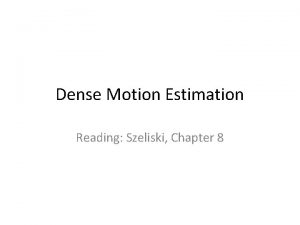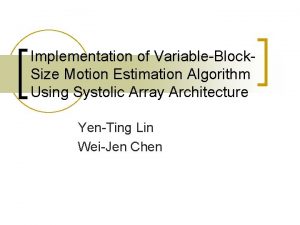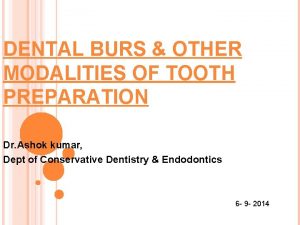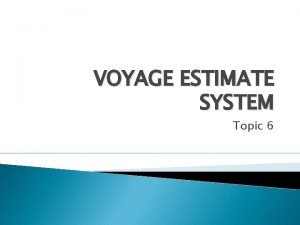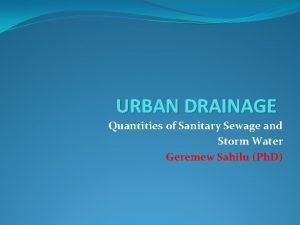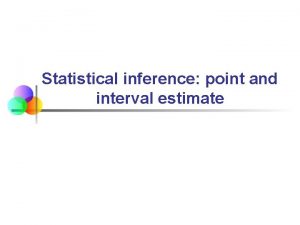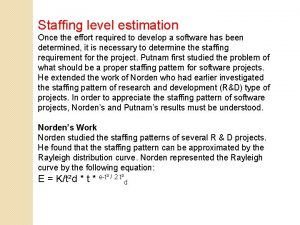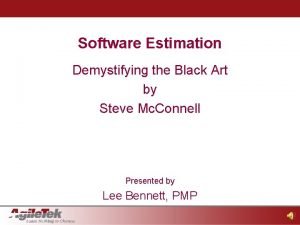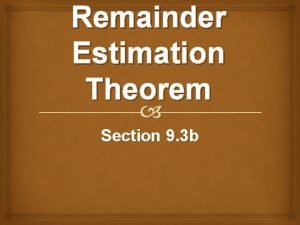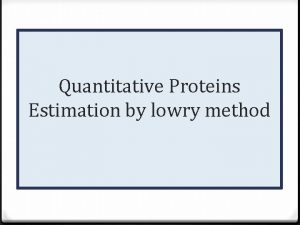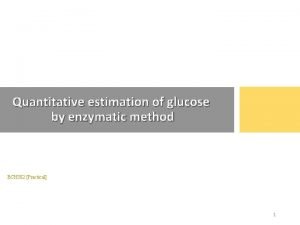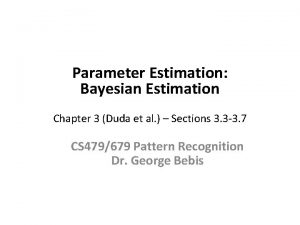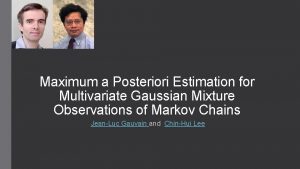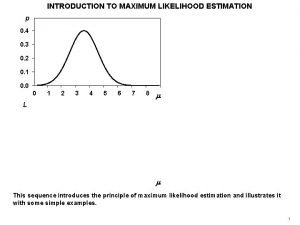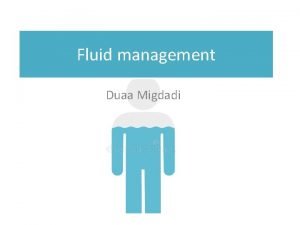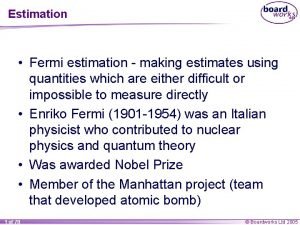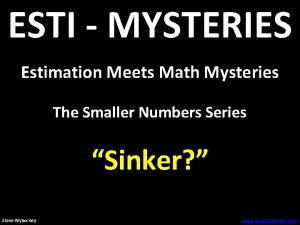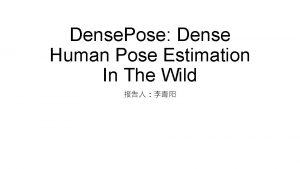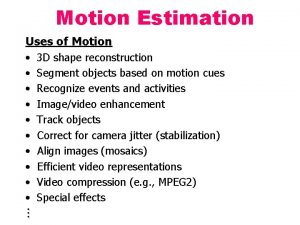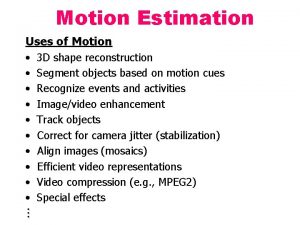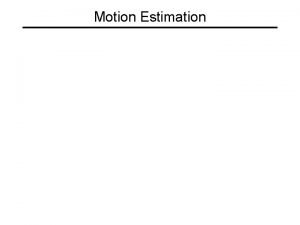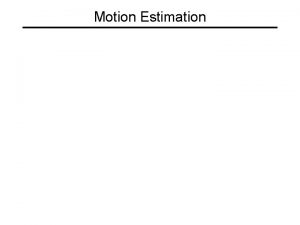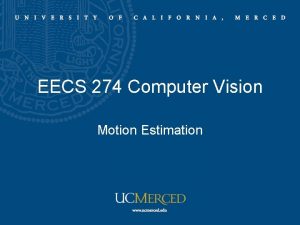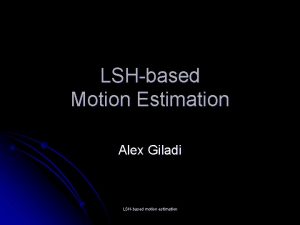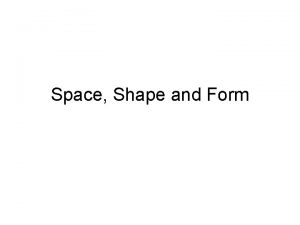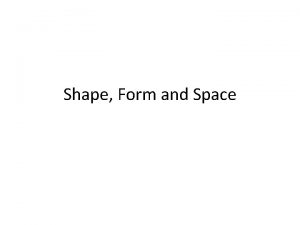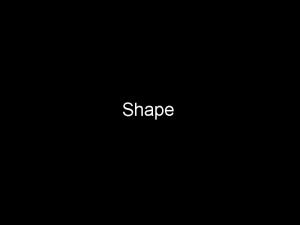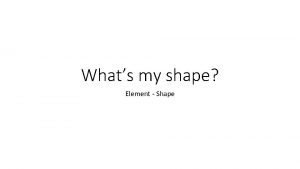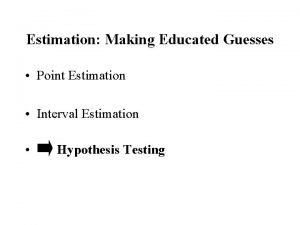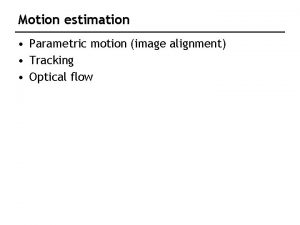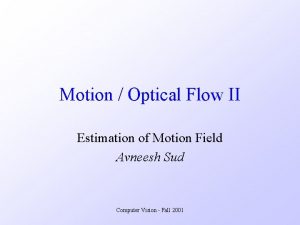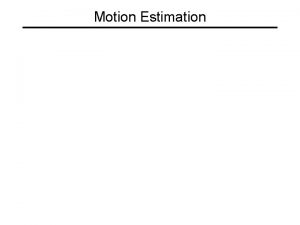Motion Estimation Uses of Motion 3 D shape










































- Slides: 42

Motion Estimation Uses of Motion • 3 D shape reconstruction • Segment objects based on motion cues • Recognize events and activities • Improve video quality • Track objects • Correct for camera jitter (stabilization) • Align images (mosaics) • Efficient video representations • Video compression (e. g. , MPEG 2) • Special effects …

Motion Estimation What affects the induced image motion? • Camera motion • Object motion • Scene structure

Motion Estimation Even “poor” motion data can evoke a strong percept

Motion Estimation Even “poor” motion data can evoke a strong percept

Motion field

Optical Flow

Example Flow Fields Possible ambiguity between zoom and forward translation Is this the Fo. E (epipole) or the optical axis ? ? ? Possible ambiguity • This lesson – estimation of general 2 D flow-fields between sideways • Next lesson – constrained by global parametric transformations translation and rotation

The Aperture Problem So how much information is there locally…?

The Aperture Problem Not enough info in local regions Copyright, 1996 © Dale Carnegie & Associates, Inc.

The Aperture Problem Not enough info in local regions Copyright, 1996 © Dale Carnegie & Associates, Inc.

The Aperture Problem Copyright, 1996 © Dale Carnegie & Associates, Inc.

The Aperture Problem Information is propagated from regions with high certainty (e. g. , corners) to regions with low certainty. Copyright, 1996 © Dale Carnegie & Associates, Inc.

Such info propagation cause optical illusions… Illusory corners

• Direct (intensity-based) Methods (Dense matches) 1. Gradient-based (differential) methods (Horn &Schunk, Lucase & Kanade) 2. Region-based methods (Correlation, SSD, Normalized correlation) • Feature-based Methods (Sparse matches)

Brightness Constancy Assumption Image I (taken at time t+1) Image J (taken at time t)

The Brightness Constancy Constraint Brightness Constancy Equation: Linearizing (assuming small (u, v)):

Observations: z Need additional constraints…

Horn and Schunk (1981) Add global smoothness term Error in brightness constancy equation Smoothness error Minimize: Solve by using calculus of variations

Horn and Schunk (1981) Inherent problems: * Smoothness assumption wrong at motion/depth discontinuities over-smoothing of the flow field. * How is Lambda determined…?

Lucas-Kanade (1981) Assume a single displacement (u, v) for all pixels within a small window (e. g. , 5 x 5) Geometrically -- Intersection of multiple line constraints Algebraically -- Solve a set of linear equations Minimize E(u, v):

Lucas-Kanade (1981) Minimize E(u, v): Differentiating w. r. t u and v and equating to 0: Solve for (u, v) [ Repeat this process for each and every pixel in the image ]

Singularites Where in the image will this matrix be invertible and where not…?

Edge – large gradients, all in the same direction – large l 1, small l 2

Low texture region – gradients have small magnitude – small l 1, small l 2

High textured region – large gradients in multiple directions – large l 1, large l 2

Linearization approximation iterate & warp estimate update Initial guess: Estimate: x 0 x

Linearization approximation iterate & warp + estimate update Initial guess: Estimate: x 0 x

Linearization approximation iterate & warp + estimate update Initial guess: Estimate: x 0 x

Linearization approximation iterate & warp + x 0 x

Revisiting the small motion assumption Is this motion small enough? Probably not—it’s much larger than one pixel (2 nd order terms dominate) How might we solve this problem?

Coarse-to-Fine Estimation Advantages: (i) Larger displacements. (ii) Speedup. (iii) Information from multiple window sizes. iterate refine u=1. 25 pixels + u=2. 5 pixels ==> small u and v. . . u=5 pixels image J Pyramid of image J u=10 pixels image I Pyramid of image I

Optical Flow Results

Optical Flow Results

Optical Flow Results Images taken from a helicopter flying through a canyon Competed optical flow [Black & Anandan] Length of flow vectors inversely proportional to depth Z of the 3 D point Points closer to the camera move faster across the image plane

Lucas-Kanade (1981) Inherent problems: * Still smooths motion discontinuities (but unlike Horn & Schunk, does not propagate smoothness across the entire image) * Local singularities (due to the aperture problem) • Maybe increase the aperture (window) size…? • But no longer a single motion… Global parametric motion estimation – next week.

Motion Magnification Wu, Rubinstein, Shih, Guttag, Durand, Freeman “Eulerian Video Magnification for Revealing Subtle Changes in the World”, SIGGRAPH 2012 Source video: baby. mp 4 Result: baby-iir-r 1 -0. 4 -r 2 -0. 05 -alpha-10 -lambda_c-16 -chrom. Atn-0. 1. mp 4 Paper + videos can be found on: http: //people. csail. mit. edu/mrub/vidmag

Motion Magnification Could compute optical flow and magnify it But… very complicated (motions are almost invisible) Alternatively:

Motion Magnification What is equivalent to? This is equivalent to keeping the same temporal frequencies, but magnifying their amplitude (increase frequency coefficient) Can decide to do this selectively to specific temporal frequencies (e. g. , a range of frequencies of expected heart rates).

Motion Magnification What is equivalent to? But holds only for small u • s and v • s Apply to coarse pyramid levels to generate larger motions

Original time Time-Magnified time

Motion Magnification Paper + videos can be found on: http: //people. csail. mit. edu/mrub/vidmag EVM_NSFSci. Vis 2012. mov Copyright, 1996 © Dale Carnegie & Associates, Inc.

Motion Magnification Paper + videos can be found on: http: //people. csail. mit. edu/mrub/vidmag. mov
 Dense motion estimation
Dense motion estimation Motion estimation algorithms
Motion estimation algorithms Airfoil nomenclature
Airfoil nomenclature Shape matching and object recognition using shape contexts
Shape matching and object recognition using shape contexts Shape matching and object recognition using shape contexts
Shape matching and object recognition using shape contexts Classification of burs
Classification of burs Uses of motion
Uses of motion Passive and active rom
Passive and active rom Shm equations
Shm equations An object in motion stays in motion
An object in motion stays in motion Chapter 2 motion section 1 describing motion answer key
Chapter 2 motion section 1 describing motion answer key Measuring motion
Measuring motion Motion section 1 describing motion
Motion section 1 describing motion Chapter 1 lesson 2 describing motion answer key
Chapter 1 lesson 2 describing motion answer key Motion section 1 describing motion
Motion section 1 describing motion Voyage estimation shipping
Voyage estimation shipping Hexokinase method principle
Hexokinase method principle Estimation of sewage flow and storm water drainage
Estimation of sewage flow and storm water drainage Stevewyborney estimation clipboard
Stevewyborney estimation clipboard Properties of good estimator
Properties of good estimator Post estimation test
Post estimation test Staffing level estimation
Staffing level estimation Software estimation demystifying the black art
Software estimation demystifying the black art Front end estimation
Front end estimation The remainder estimation theorem
The remainder estimation theorem Protein estimation by lowry method
Protein estimation by lowry method Enzymatic method of blood glucose estimation
Enzymatic method of blood glucose estimation Objectives of cost estimation
Objectives of cost estimation Bayesian estimation
Bayesian estimation Maximum a posteriori estimation for multivariate gaussian
Maximum a posteriori estimation for multivariate gaussian Types of demand forecasting in managerial economics
Types of demand forecasting in managerial economics Maximum likelihood estimation
Maximum likelihood estimation Sahli's method diagram
Sahli's method diagram Third spacing
Third spacing What is 239 rounded to the nearest hundred
What is 239 rounded to the nearest hundred Conjugated bilirubin calculation
Conjugated bilirubin calculation Chromoprotien
Chromoprotien Fermi estimation example
Fermi estimation example Estimation and costing in electrical engineering
Estimation and costing in electrical engineering Contoh soal estimasi
Contoh soal estimasi Steve wyborney esti mysteries
Steve wyborney esti mysteries Dense pose estimation
Dense pose estimation Software cost estimation notes
Software cost estimation notes
